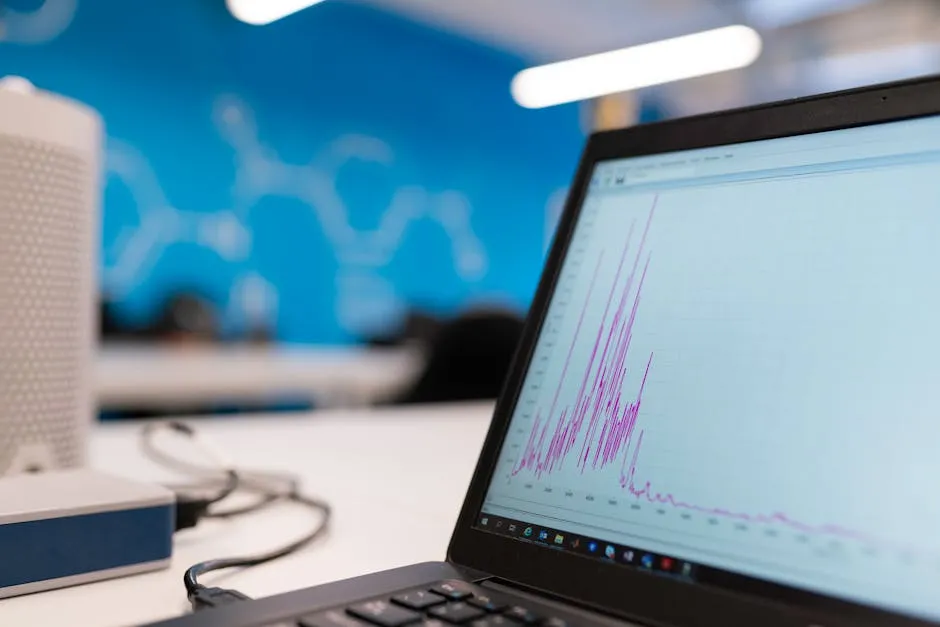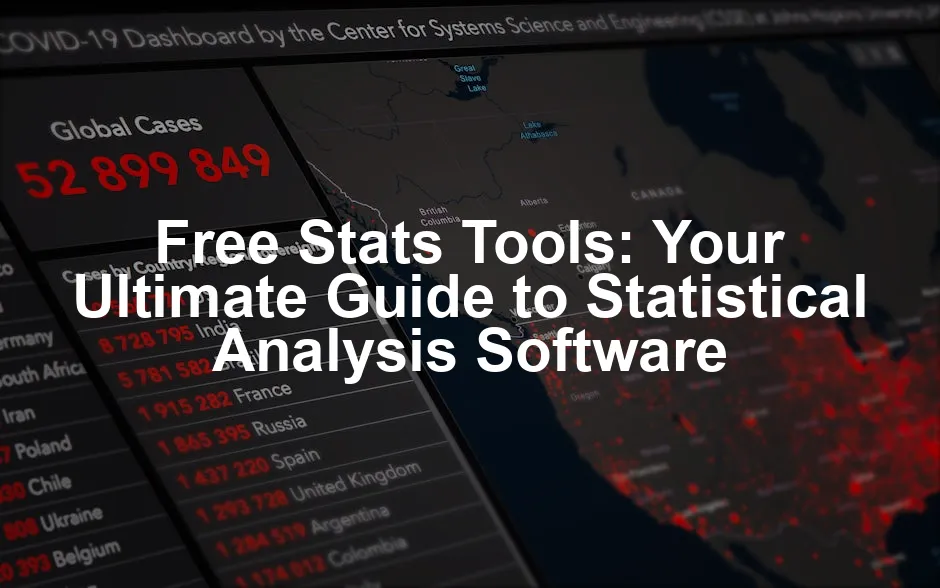Introduction
Statistical analysis is essential across many fields. Whether in business, healthcare, or academia, it helps us make informed decisions. Fortunately, free statistical tools are now available for individuals and organizations on a budget. These tools have gained popularity, proving that quality analysis doesn’t have to come with a hefty price tag.
Summary and Overview
Statistical software has evolved significantly over the years. Initially, most options required expensive licenses, limiting access to large organizations. Today, a shift towards free and open-source tools has emerged, making statistical analysis more accessible. For more information on the best tools available, check out this guide on top statistical software for analyzing national statistics authority philippines data.
Understanding the evolution of statistical software is important for choosing the right tools. Learn more about this topic here.
Using free statistical tools offers numerous benefits. First, they save costs, allowing students and startups to analyze data without financial constraints. Additionally, many of these tools boast strong community support, fostering collaboration and knowledge-sharing.
The functionalities of free statistical software are impressive. They range from basic descriptive statistics to complex analyses, empowering users to tackle various data challenges. With these tools, anyone can harness the power of data analysis without breaking the bank. If you want to dive deeper into the world of statistical analysis, consider grabbing a copy of R and RStudio. It’s a fantastic resource for beginners and seasoned analysts alike!

Top Free Statistical Tools
Overview of Popular Free Statistical Tools
When selecting statistical tools, consider a few key factors. First, ease of use is crucial. Tools should have intuitive interfaces to minimize the learning curve. Next, functionality matters. The software should support a variety of statistical analyses and methods. Finally, community support is vital. A strong user community can offer resources, troubleshooting, and updates.
Here are some top choices for free statistical tools:
- R and RStudio
- JASP
- Jamovi
- GNU PSPP
- SOFA Statistics
1. R and RStudio
Features and Benefits
R is a powerful programming language for statistical computing and graphics. It excels in data manipulation, statistical modeling, and visualizing data. Its extensive package ecosystem allows users to perform complex analyses with ease. To get started with R and RStudio, you can check this comprehensive guide on how to install R and RStudio.
Getting started with R and RStudio can enhance your statistical analysis capabilities. Find the installation guide here.
RStudio serves as an excellent interface for R. It simplifies coding with features like syntax highlighting and project management. This makes R more accessible, especially for beginners and those who prefer a graphical interface.

2. JASP
User-Friendly Interface
JASP is designed for both Frequentist and Bayesian analyses. Its intuitive layout makes it easy to navigate and conduct statistical tests. Users can drag and drop data into the interface and instantly see results. To get a more in-depth understanding of JASP, consider picking up JASP. It’s a great resource that can help you maximize the tool’s potential!
JASP emphasizes reproducibility, allowing users to export results in APA format. This combination of usability and functionality makes JASP a favorite among researchers and educators.

3. Jamovi
Simplicity and Power
Jamovi stands out for its intuitive design. Built on R, it opens the door to powerful statistical analysis. You don’t need advanced coding skills to use it. The user-friendly interface feels similar to familiar spreadsheet applications. This design makes it approachable for beginners and seasoned analysts alike.
With Jamovi, you can perform various statistical tests effortlessly. It supports everything from descriptive statistics to complex analyses. Instant feedback on your data enhances the learning experience. Plus, you can easily share results in professional formats like APA. Jamovi truly democratizes statistical analysis for all users. If you’re looking to expand your knowledge on statistical analysis, consider the book Jamovi it offers great insights!

4. GNU PSPP
SPSS Alternative
GNU PSPP is a robust alternative to SPSS. It retains a familiar interface, making it easy for SPSS users to transition. This tool excels at performing a variety of statistical tests, including descriptive statistics and regression analysis. For a deeper dive into using PSPP, consider the book GNU PSPP. It’s a fantastic resource for users looking to enhance their PSPP skills!
PSPP is designed for efficiency and speed, handling large datasets with ease. It supports multiple file formats, enhancing its versatility. The software is open-source, ensuring continuous improvement through community contributions. For anyone seeking a free option that mimics SPSS functionality, PSPP is an excellent choice.

5. SOFA Statistics
Reporting and Usability
SOFA Statistics emphasizes user-friendly reporting and ease of use. Its interface is designed for quick navigation, allowing users to conduct analyses without extensive training. You can generate clear, visually appealing reports with just a few clicks. For a more comprehensive understanding of SOFA, consider the book SOFA Statistics. It’s a great companion for anyone looking to enhance their reporting skills!
This tool supports a wide range of statistical tests, suitable for diverse analytical needs. Automated reporting features save time while ensuring accuracy. SOFA’s focus on usability makes it a great option for educators and researchers seeking to present data effectively. With SOFA, statistical analysis becomes straightforward and accessible.

6. Python (with Libraries)
Versatility with Libraries
Python is renowned for its flexibility in data analysis and statistical computing. Its extensive libraries, like pandas and NumPy, enhance data manipulation capabilities. Python’s syntax is straightforward, making it accessible for users at all levels. If you want to dive deeper into Python for data science, check out Python Programming for Data Science. It’s a must-read!
By leveraging libraries like SciPy and StatsModels, you can perform complex statistical analyses. This versatility makes Python a favorite among data scientists and analysts. Whether you’re cleaning data, running regressions, or visualizing results, Python has the tools you need. With its open-source nature, the community continually develops new features and improvements.

7. SciLab
Advanced Analysis
SciLab is a powerful tool for engineering and scientific data analysis. Its applications range from signal processing to fluid dynamics. You can perform complex mathematical computations with ease. SciLab’s extensive library supports numerical analysis and graphical visualization. This makes it suitable for researchers and engineers alike. If you’re interested in leveraging SciLab for your projects, check out SciLab for Engineers. It’s a fantastic guide to help enhance your engineering analyses!
The tool’s flexibility allows users to build custom algorithms for specific needs. Whether you’re simulating physical systems or analyzing experimental data, SciLab provides robust solutions. Its open-source nature fosters collaboration among users, enhancing its capabilities over time.

8. MacAnova
Interactive Analysis
MacAnova stands out for its interactive capabilities in statistical analysis. It excels at matrix algebra, making it ideal for advanced data manipulations. With MacAnova, you can perform various hypothesis tests, ensuring thorough analysis of your data. The software also supports graphical representations, aiding in data visualization. If you’re looking to use MacAnova effectively, consider the MacAnova User Guide. It’s a helpful resource for mastering this tool!

9. DATAtab
Online Calculator
DATAtab simplifies statistical calculations with its user-friendly interface. This online calculator caters to both beginners and seasoned professionals. Users can quickly input data and select desired analyses. The tool automatically chooses the appropriate methods, streamlining the process. For a better understanding of how to utilize DATAtab, consider the book DATAtab Statistical Calculator. It’s a must-have for efficient calculations!
DATAtab supports a range of statistical tests, from descriptive statistics to advanced hypothesis testing. Its accessibility means you can perform analyses from any device without installation. The platform also offers tutorials for users seeking to improve their statistical knowledge. With DATAtab, complex calculations become manageable and straightforward.

10. Other Notable Mentions
There are several other noteworthy free statistical tools worth considering. ViSta offers a visual approach to statistics, making data analysis intuitive. PAST is popular for ecological data analysis, providing extensive functionality. OpenStat combines a user-friendly interface with a wide range of statistical methods. Each of these tools complements the others, catering to diverse analytical needs. Exploring these options can enhance your statistical toolkit and expand your analysis capabilities. And if you’re looking for resources to help with data visualization, consider checking out Data Visualization Tools. They can really help bring your data to life!

Benefits of Using Free Statistical Tools
Cost-Effectiveness
Free statistical tools significantly reduce barriers for students and startups. They allow access to powerful analytics without the financial burden of paid software. This democratization of data analysis empowers individuals and organizations to make informed decisions. With these tools, anyone can harness the power of statistical analysis without breaking the bank. And while you’re at it, why not invest in a Graphing Calculator? It’s a great tool for visualizing your data in real-time!

Community Support
Community-driven support is crucial for open-source tools. These platforms thrive on user contributions, enhancing the software’s functionality. When users share tips, tutorials, and troubleshooting advice, everyone benefits. You can find solutions to common problems faster. This collaborative spirit fosters learning and innovation among users. As new features are developed, the community often provides feedback, ensuring the tools evolve to meet user needs. Overall, community engagement amplifies the value of free statistical tools, making them more robust and user-friendly.

Customization and Flexibility
One major advantage of free statistical tools is their customization potential. Users can adapt these tools to suit specific project requirements. This flexibility allows you to modify features, add plugins, or even write custom code. Whether you need unique analyses or specific visualizations, these tools can evolve with your demands. This adaptability empowers users to create tailored solutions without being restricted by commercial software limitations. In essence, free tools are versatile, allowing you to mold them to fit your analytical needs perfectly. And if you’re looking for a comfortable workspace while you analyze data, consider investing in an Ergonomic Office Chair. It’s a game-changer for long analysis sessions!

Transitioning to Free Tools: Tips for Success
Invest in Learning
To maximize your experience with new software, invest time in learning. Online tutorials are abundant and offer great insights into using free statistical tools. Websites like YouTube and dedicated forums provide step-by-step guides. Additionally, consider enrolling in free online courses that focus on these tools. By enhancing your skills, you’ll feel more confident in your analyses. Don’t hesitate to explore community resources, as they often contain valuable tips from experienced users. Learning will make your transition smoother and more enjoyable. And while you’re learning, keep your workspace organized with a Desk Organizer Set to maintain focus!

Stay Updated
Keeping your software updated is essential for optimal performance. Free tools often receive regular updates, fixing bugs and introducing new features. Check for updates frequently to ensure you’re using the latest version. This practice enhances security and ensures access to the newest functionalities. Many tools offer automatic updates, making it easier for you. Staying current means you can tackle data analysis challenges more efficiently and effectively. Plus, you’ll benefit from the latest improvements that can simplify your workflow. Staying organized is key; consider using Cable Management Clips to keep your workspace tidy!
Contribute to the Community
Engaging with community forums is a great way to enhance your experience. By participating, you can ask questions, share insights, and learn from others. Your contributions can help fellow users overcome challenges. Whether it’s reporting bugs or suggesting improvements, your input is valuable. Engaging in discussions can also deepen your understanding of the tools. Plus, you may find opportunities to collaborate on projects. Building connections in the community will enrich your statistical journey and expand your network.
Conclusion
Free statistical tools provide numerous advantages for data analysis. They are cost-effective, accessible, and often come with robust community support. These tools allow users from all backgrounds to perform complex analyses without financial constraints. By exploring these options, you can enhance your analytical capabilities significantly. We encourage you to try various free tools and find the ones that best suit your needs. Don’t forget about the power of visualization; consider investing in Digital Notepad to capture your insights on the go!
Please let us know what you think about our content by leaving a comment down below!
Thank you for reading till here 🙂
All images from Pexels




